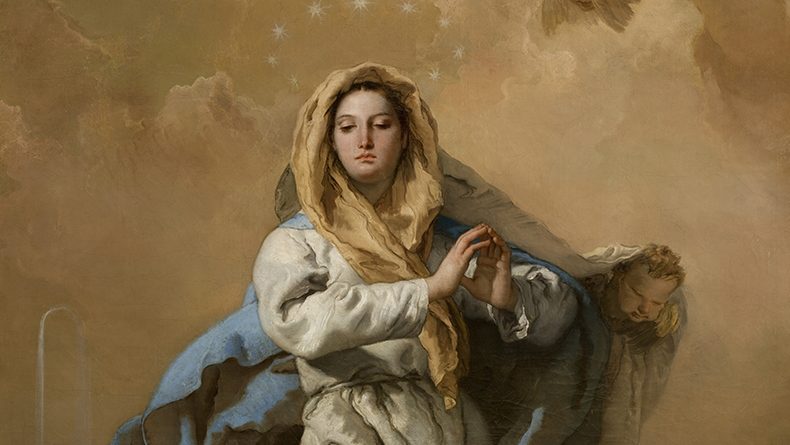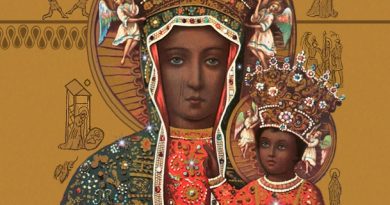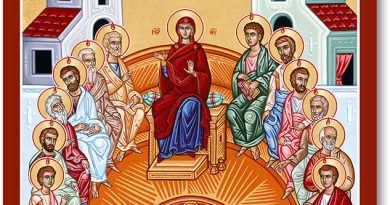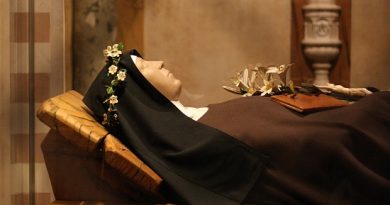The Immaculate Conception of Mary
On Thursday, 8 December 2022, we celebrate the Immaculate Conception of Mary. This important belief in our Christian faith has a solid biblical foundation.
To begin with, God is revealed from Scripture as perfect interior holiness. In Isaiah 6:3 we find: And one called to another [the seraphims] and said: “Holy, holy, holy is the LORD of hosts. Furthermore, the Bible tells us that no sin or anything tainted with sin can stay in God’s holiness. Hence, “enmity” is that mutual hatred between Mary and sin, between Christ and sin. God says in Genesis 3 verse 15: I will put enmity between you and the woman, and between your seed and her seed; he shall bruise your head, and you shall bruise his heel.
Let us not forget either the salutation by the Angel Gabriel which shows that Mary was particularly “highly favored with grace” (Gk.: charitoo, used twice in the New Testament, in Lk 1:28 for Mary – before Christ’s redemption; and Eph 1:6 for Christ’s grace to us – after Christ’s redemption). In Luke 1:28 we read: And he came to her and said, “Hail, O favored one, (kecharitomene)”.In the Letter to the Ephesians 1:4-6, we read: 4] He [God] chose us in him before the foundation of the world, that we should be holy and blameless before him. He destined us in love to be his sons through Jesus Christ, according to the purpose of his will, to the praise of his glorious grace which he freely bestowed on us in the Beloved.
Also, the constant faith (paradosis) of the Church confirms the belief in the special preparation of the holiness of the person of Mary to bear in her body the most holy person of the Son of God. Post-Apostolic faith kept harping on the Immaculate Conception of Mary. In fact, the Fathers of the Church drew that important parallelism between Eve and Mary, especially St Irenaeus of Lyon (140-202). With the latter we also find St Ephrem of Syria (306-373) and St Ambrose of Milan (339-397) who use very important words in this regard concerning Mary such as “holy”, “innocent”, “most pure”, “intact”, “immaculate”. With St Augustine of Hippo (354-430) and St Anselm of Canterbury (1033 to 1114) we encounter the explicit usage of the term Mary free from original sin. Liturgically speaking, the Eastern Church celebrated a Feast of the Conception of Mary in the 8th to 9th Century.
On the other hand, the Western Church celebrated a Feast of the Conception of Mary in the 12th Century. Moreover, we have available a record of the feast in the 11 Century in Britain whereas in the 12th century we have it in Normandy. The Feast of the Conception of Mary was wisely celebrated in many churches like in France, Germany, Italy and Spain in the 12th Century. However, the 14th century was a period noted for its opposition to the Immaculate Conception, even from some of the great doctors of Scholasticism itself. Having said that the feast was still being celebrated. The difficulty these doctors found was about how this could bre related to the universal redemption through Christ. Providentially, the Franciscan theologians solved this theological difficulty by reasoning that Christ, the most perfect mediator, preserved Mary from original sin by a correspondingly perfect act of healing.
The great Franciscan theologian, Blessed John Duns Scotus, said that (1266-1308) reasoned that the Immaculate Conception came through God’s application of the grace of Christ beforehand. From the 15th Century the Feast was universally celebrated to the extent that christian piety introduced an oath to defend the belief in the Immaculate Conception to be taken not only by Religious, but also by non-Religious and at the Universities, such as in Paris in 1497; Cologne in 1499 and Vienna in 1501. From the 17th Century we encounter with the clause “to the shedding of blood”. This was added to the oath taken to defend the belief in the Immaculate Conception. It was Pope Blessed Pius IX, who infallibly defined, ex cathedra, that the Blessed Virgin Mary, in the first instant of her conception, by a singular grace and privilege of Almighty God, and in view of the foreseen merits of Jesus Christ, the savior of the human race, was preserved free from all stain of original sin.
In naming the content of Divine Revelation after God has revealed it to us, the Church reflects a long Biblical tradition and practice.
Pope Francis offers us some beautiful reflections concerning the Immaculate Conception of Mary. In his Angelus Address of December 8, 2022, he urged us, as Christians, to follow a path of conversion precisely as we find hope in the special grace Mary received from God. Just before the Marian prayer, in his little catechesis which he shared with those present, Pope Francis wonderfully reflected on how Mary offers us a foretaste of the blessedness of eternal life. He said: She too was saved by Christ but in an extraordinary way, because God wanted that the mother of His Son not be touched by the misery of sin from the moment of her conception.
Furthermore, the Pope said that the Blessed Virgin Mary was free from any stain of sin throughout her entire life thanks to a singular action of the Holy Spirit so as to always remain in perfect relationship with her Son Jesus. The Holy reiterated that the every human being is created by God for the fullness of holiness, as St. Paul says in the Second Reading of the day’s liturgy (Eph 1:3-6, 11-12). He said: What Mary had from the beginning, will be ours in the end, after we have passed through the purifying ‘bath’ of God’s grace.
The Pope stated that even the most innocent people were marked by original sin and fought with all their strength against its consequences. He said that the first person we are sure entered paradise was a ruffian: one of the two who was crucified with Jesus. For Pope this is a sign that God’s grace is offered to everyone.
Within the same catechesis, Pope Francis warned us a Christians to be careful. He said: It does not pay to be clever – to continually postpone a serious evaluation of one’s own life, taking advantage of the Lord’s patience. Hence, there is no time like the present to to seize the day. We are to do so not in the world sense of enjoying every passing moment, but in a Christian sense. He said: To say ‘no’ to evil and ‘yes’ to God, to once and for all stop thinking of ourselves, dragging ourselves into hypocrisy and to face our own reality as we are –this is who we are – to recognize that we have not loved God and neighbor as we should have. When we have taken the opportunity of acknowledging our failings, we should confess it in the Sacrament of Reconciliation and then seek to repair the harm we have done to others.
The Pope rightly said that this challenging journey of conversion is our path for becoming holy and immaculate. The Holy Father observed: The uncontaminated beauty of our Mother is incomparable, but at the same time it attracts us. Let us entrust ourselves to her and say ‘no’ to sin and ‘yes’ to Grace once and for all.
Let us pray daily to Our Lady and Mother, Mary Immaculate, this powerful prayer: O Mary, you entered the world without stain. Obtain from God that I may leave it without sin.
Fr Mario Attard OFM Cap





